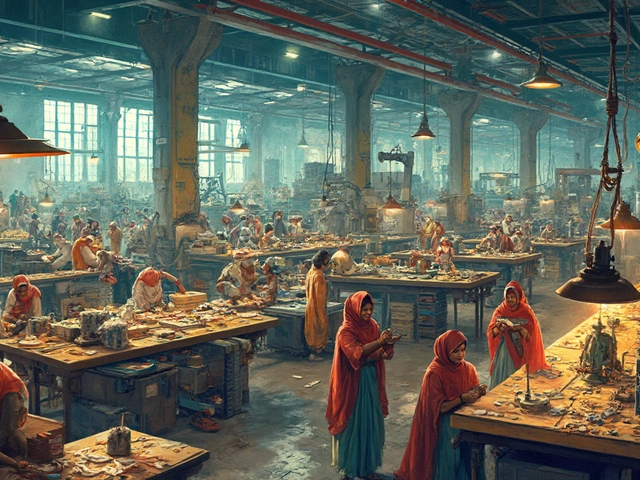
Picture this: two giants in the American steel industry possibly joining forces, or even going head-to-head in a mega buyout. It’s not every day you hear whispers about Nucor—America's largest steel producer by production tonnage—having even half an eye on U.S. Steel, a symbol of American industrial might from the days when steel barons ruled the land. Toss that rumor into the business news cycle, and suddenly, every analyst, investor, and steelworker starts asking the same question: "Is Nucor really buying U.S. Steel?"
The Steel Industry's Landscape: Players, Power Moves, and Why It Matters
No industry plays a bigger behind-the-scenes role in American infrastructure than steel. We're talking about roads, bridges, skyscrapers, solar farms, even your favorite car’s frame. Nucor is the biggest game in town if you’re measuring raw steel output, but U.S. Steel has the name that still echoes in everything from Wall Street to the hills of Pennsylvania and the city blocks of Pittsburgh.
Today, Nucor stands as a lean, mean, recycling machine. It’s grown into the largest steel producer in the United States thanks to a model focused on electric arc furnaces. These are highly efficient and run on scrap, making Nucor a strong bet for folks wanting to invest in a cleaner, more sustainable steel future. Here’s a fun fact: Nucor pumped out roughly 20.6 million tons of steel in 2024, much of it from recycled sources. Meanwhile, U.S. Steel hit about 14 million tons, but their blast furnaces have been a harder sell in a world tightening up on emissions.
But output isn’t the whole story. The real question stomping through every boardroom in 2025 is this: Who’s positioned best for the next 50 years? Nucor has $34 billion in sales (2024 numbers), far outpacing U.S. Steel’s $18.8 billion. Profits tell a similar tale. For most of the past decade, U.S. Steel has been fighting off debt, plant closures, and the pressure of heavy legacy costs. Nucor, on the other hand, is well-capitalized, efficient, and enjoys an almost cult-like respect among investors for how it treats workers—everyone from mill hands to HQ suits shares in the profit pie, which isn’t standard practice in old-school steel.
Why does a possible merger matter? Besides the obvious effect on jobs, competition, and product prices, the steel industry is the backbone of national security arguments and infrastructure spending bills. That’s a lot of political heat and Wall Street speculation for two companies to handle even on their own.

Rumors, Realities, and Wall Street Chatter: Tracing the Nucor–U.S. Steel Speculation
The actual talk of Nucor buying U.S. Steel isn’t born from thin air. In late 2023, Cleveland-Cliffs—a major U.S. steel competitor—offered $7.3 billion in cash and stock for U.S. Steel. That set off a feeding frenzy. ArcelorMittal, another steel behemoth, tossed their hat in the ring for a minute. China’s Baosteel and even some private equity firms sniffed around. But Nucor? Their CEO, Leon Topalian, stirred the pot during a quarterly earnings call in February 2025 by playing coy: "We’re always looking for opportunities that strengthen our ability to compete and innovate." That’s Wall Street speak for "Never say never."
But as of today—June 26, 2025—Nucor has not made a formal bid for U.S. Steel. Not a single regulatory filing confirms serious talks. However, reliable sources like Bloomberg and Reuters have reported that some advisors have broached the topic with Nucor's leadership. Investors have picked up on insider buzz: Nucor’s stock spiked 4% in early May on rumors. U.S. Steel also jumped 8% at the first sniff of a potential bidding war—numbers that don’t move just because of idle chatter.
Here’s where things twist. Nucor has a $35 billion market cap—over three times U.S. Steel’s, which is currently valued just north of $10 billion. That means Nucor can, if it wants to, go shopping. But the steel world is fiercely protective of its American roots. Even the White House gets cagey anytime there’s international interest, citing concerns over critical infrastructure. One Washington insider told the Wall Street Journal in June that a Nucor buyout would be "far more palatable for Congressional review than a foreign takeover." Nucor’s all-American profile might just be its biggest advantage if it ever makes a move.
| Company | 2024 Steel Production (mn tons) | 2024 Revenue (USD bn) | Market Cap (USD bn) |
|---|---|---|---|
| Nucor | 20.6 | 34 | 35 |
| U.S. Steel | 14 | 18.8 | 10 |
| Cleveland-Cliffs | 17.1 | 22 | 16 |
There’s real money on the line, too. In a Merrill Lynch industry note from April 2025, analysts argued that a Nucor-U.S. Steel deal could save anywhere from $900 million to $1.3 billion annually in synergies. That’s a big chunk of change. These savings come not just from plant closures, but by merging supply chains, axing duplicative HQ roles, and leveraging Nucor’s know-how in scrap-based steelmaking.
Of course, it’s not just about numbers. If Nucor goes for the deal, there will be plenty of regulatory scrutiny. Antitrust watchdogs, the United Steelworkers union, and environmental groups all have a say. And they can stall or even kill a deal if enough public or political pressure mounts. Insiders recall that when U.S. Steel tried to buy National Steel two decades ago, it took nearly a year for regulators to sign off—and that deal was half the size.

What a Nucor–U.S. Steel Deal Would Mean for the Industry, Workers, and You
If Nucor decides to buy U.S. Steel, you can bet the aftershocks will ripple across the entire American economy. For folks working at U.S. Steel, the buzz on the ground feels tense. Some see hope in Nucor’s rep for investing in even struggling plants, not just gutting them. Nucor pays better than most steel giants, too, and their bonus system can eclipse union contract wages in good years. Others wonder if more robots and new tech will mean layoffs, and if union contracts will survive the transition.
Now, investors are licking their lips at the prospect. When big, efficient players buy legacy firms, stocks usually pop in the short term. But not always. Remember when AT&T snatched up Time Warner in media? Plenty of folks made money quick, but long-term the synergies (that’s a five-dollar word for "making things work together") can fall flat. Steel is different from media, but you get the vibe—these deals aren’t always slam dunks.
The five biggest ripple effects to watch for if this deal ever lands:
- Nucor cements itself as the undisputed king of American steel, with more capacity and footprints than anyone else.
- New technology—from green hydrogen to better recycling—might accelerate as combined R&D gets a big budget boost.
- Job cuts in sales, admin, and management, but also real momentum for high-skilled workers on the tech and engineering side.
- Product prices could get stickier if competition falls, but U.S. antitrust rules are strict. Don’t expect a free-for-all on price hikes.
- Steel-dependent sectors like auto and construction might see more stable supply, with fewer production halts from plant breakdowns or strikes.
And what about the folks behind the scenes? If you’re someone like my friend Paul out in Gary, Indiana—he’s worked in U.S. Steel since the early 2000s—you’re glued to every news flash. There’s family history at stake, and lots of small towns worry that buyouts lead to more empty factories not fewer. Still, Nucor has a track record of making slow, careful transitions, offering retraining for mill workers who want to stay onboard.
Tips for anyone riding this out—whether you’re an employee, investor, or local businesspartner:
- Pay attention to official SEC filings, not just headlines. If Nucor files an 8-K or a merger notice, that’s when it’s real.
- Workers should make sure their union reps are actively talking to Nucor and U.S. Steel management. Job guarantees and retraining packages can get hammered out before deals close.
- If you’re an investor, don’t get blinded by the hype. Look for concrete cost-saving plans and leadership comments on culture and integration, not just heady forecasts.
Here’s one last thing—any deal this big gets second-guessed. Going back to long before I met Lorelei, I’ve watched "can’t-miss" mergers stumble when cultures clash or when outside events (recessions, new tariffs, you name it) hit at the worst time.
For now, is Nucor buying U.S. Steel? Not yet. But keep your eyes peeled—the steel market is hot, the rumors are hotter, and the next move could reshape America’s industrial future for decades to come.




